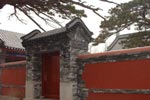
While most people associate Haidian with high-tech and many of China's best universities and research institutes, the district also has a refreshingly rural side good for day trips or overnight getaways without leaving the confines of the municipality.
It's easy to forget how big a place the Beijing Municipality truly is.
Its urban core, inner and outer suburban districts combined with outlying counties under its jurisdiction make the Chinese capital slightly more than half the size of Belgium. Encompassing an area of 426-square kilometers, Haidian's population of approximately two million is 90 per cent urbanized, concentrated mainly in the southern and eastern sections of the district.
The village of Niegezhuang, located in the northwestern corner of Haidian, bordering Mentougou and Changping districts, is a mountainous region dotted with the ruins of forgotten temples, Buddhist nunneries,cave shrines and pagodas going as far back as the Northern Wei dynasty(386-534 AD).
This small town is not immune to the effects of the city's creeping urbanization; however the picturesque parts worth checking out are protected within the confines of the Phoenix Mountain Nature Park (Fenghuang Ling Ziran Fengjing Qu). Admittance is 10 yuan per person, and 2 yuan for vehicles. If you speak Chinese, call 6245-9492 or 6245-5933 for more information.
The park is approximately 35 kilometres away in a straight line northwest from Tiananmen Square. Getting there from the city centre by car or taxi takes a minimum of an hour and possibly much longer depending on the time of day and date you decide to visit. From the north side of the Summer Palace, the roads you want are called Heishanhu Lu, Heilongtan Lu, then Wenbei Lu. Once you're in Neigezhuang, Longquan Lu takes you to the park gate.
Readers might want to file this article away as a trip to do during warmer weather. The park is open, but a cluster of sites in its northern part requiring a three hour hike to visit are inaccessible because of snow and icy conditions making the paths dangerous. Locals say this part of Haidian is 3-5 degrees cooler than the rest of the city year round.
Many houses have rocks put on top of roof tiles to keep them from being blown away by strong winds.
God of War Temple
Another reason to wait for better weather is the Guandi Miao (God of War Temple) inside the park. Newly restored, it is not yet open to the public. Villagers say that replacement statues ordered from Fujian Province are due to arrive in the spring of 2004.
Temples dedicated to the God of War were once one ubiquitous in Beijing, celebrating the manly and public virtues of the historical figure Guan Yu (162-220 AD). Guan was especially venerated during the Qing dynasty for his bravery, loyalty and legendary martial skills known throughout China.
Dragon Spring Temple
Longquan Si, or Dragon Spring Temple, has a history of more than a thousand years, dating from the Liao dynasty (926-1125). After passing through the main gate visitors cross Golden Dragon bridge spanning the source of the spring. There is a legend that at the bottom of the pool is a golden teapot large enough to slake the thirst of nine people.
Other features of the temple compound include two large Maidenhair trees that still bear ginko fruit despite being there for a millennium, and a small pagoda containing the remains of a Buddhist master surnamed Wei. A large pair of stone shoes sits at the base of the reliquary.
(Beijing Weekend December 26, 2003)
|

